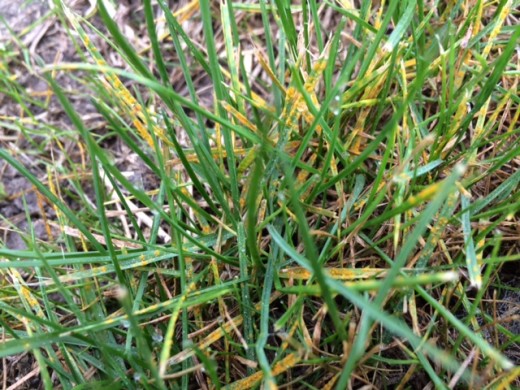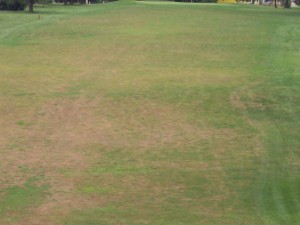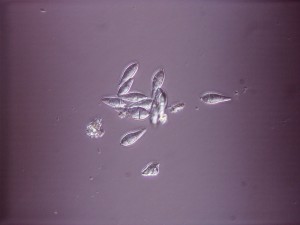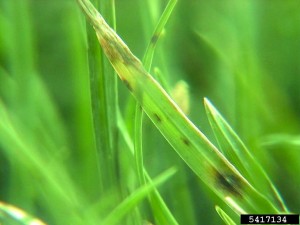 Perennial ryegrass has been widely used in the transition zone over the years. It used to be quite popular, but disease issues and water costs have reduced its use in Kansas. That said, it’s what makes Augusta National Golf Club beautiful for the Masters. Learn more about perennial ryegrass HERE.
Perennial ryegrass has been widely used in the transition zone over the years. It used to be quite popular, but disease issues and water costs have reduced its use in Kansas. That said, it’s what makes Augusta National Golf Club beautiful for the Masters. Learn more about perennial ryegrass HERE.
Tag: perennial ryegrass
Rust on Turfgrass
(By Jared Hoyle, KSU Turfgrass Research and Extension)
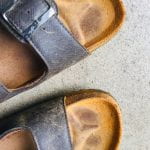 Last week I came home after the KSU Turfgrass Annual Field Day that was held in Olathe, KS at the Olathe Horticulture Research and Extension Center and before I even made it into the house I knew I had rust in our back yard. The shoes in the garage were a dead give away. The shoes that my wife were wearing in the back yard were orange. This disease can occur just about anywhere, when the leaves of turf are wet and when plants are stressed they are more susceptible. We see it on perennial ryegrass but can occur on other species.
Last week I came home after the KSU Turfgrass Annual Field Day that was held in Olathe, KS at the Olathe Horticulture Research and Extension Center and before I even made it into the house I knew I had rust in our back yard. The shoes in the garage were a dead give away. The shoes that my wife were wearing in the back yard were orange. This disease can occur just about anywhere, when the leaves of turf are wet and when plants are stressed they are more susceptible. We see it on perennial ryegrass but can occur on other species.
Don’t worry too much as the turf typically can grow out of it.
For more information on rust check out the KSU publication below, some past blog posts from Dr. Megan Kennelly and myself, as well as some information from Richard Jauron at Iowa State University.
https://www.bookstore.ksre.ksu.edu/pubs/EP163.pdf
https://blogs.k-state.edu/turf/tag/rust/
https://blogs.k-state.edu/turf/rust-activity-in-turfgrass/
Got perennial ryegrass? It’s the time of year to think about gray leaf spot
(Megan Kennelly, KSU Plant Pathology)
Gray leaf spot is a serious disease of perennial ryegrass that can quickly blight large areas of turf. The disease is caused by the fungus Pyricularia grisea. In Kansas, turfgrass managers with perennial ryegrass often spray fungicides preventatively right around now, in early to mid August, sometimes with a follow-up application (or 2) to provide protection through September, depending on weather. This year, I’ve heard some reports that people have seen activity earlier than usual, which is definitely possible with all the rain.
This disease can be so bad that a lot of golf courses have switched to other turfgrass species (zoysia, bluegrass, bent – though bent has some nasties, too) so that they don’t have to worry about it in their fairways.
Here is a fairway that went from healthy to severely damaged in a short time, a couple of years ago. They switched to Kentucky bluegrass.
The fungus sporulates profusely and can spread fast when weather is conducive to disease (82-90 degrees with humidity and leaf wetness). Here are some of the spores in the microscope from a sample I got a couple of years ago:
Early symptoms look like this – small leaf spots the color of a Hershey bar:
(Photo courtesy Ned Tisserat, Colorado State University, Bugwood.org)
The spots grow and develop a gray center.
If you are managing rye, you are probably already thinking about gray leaf spot, and maybe you’ve just done your first app or have it on the docket soon. For some more details on management and fungicides, check out the gray leaf spot section (starts on p. 13) in this publication:
http://www2.ca.uky.edu/agc/pubs/ppa/ppa1/ppa1.pdf
There are more photos and details on the disease at this website as well, from an excellent publication by Barb Corwin and my predecessor Ned Tisserat:
http://extension.missouri.edu/p/IPM1029-11#Grayleafspot
Now – I gotta get back into the lab. I’ve got some more sick turf, a dying chrysanthemum, and a really nasty potato (mushy and stinky – eewww) to deal with by the end of the day.
